




Optical astronomy has provided us with a wealth of information about our solar system. Space missions have shown us detailed, close up views of the planets and their moons. Through visible light observations we have studied comets and asteroids as well as the surface of the Sun. What more can we learn about our solar system by studying the light from other parts of the spectrum? Multiwavelength studies give us information about the different layers in the atmospheres of planets and some of their moons. The same is true of the Sun - observing the Sun in different parts of the spectrum allows us to study details in different layers of the solar atmosphere. Did you know that comets emit X-rays? Why this happens is still a mystery. Infrared observations have shown us that our solar system is filled with comet dust and that the giant planets Jupiter, Saturn, and Neptune not only reflect heat from the Sun, but create their own heat as well. Ultraviolet observations have led to the discovery of auroras on both Jupiter and Saturn.
Below is what Venus, the second planet from the Sun, looks like when viewed in different parts of the electromagnetic spectrum.
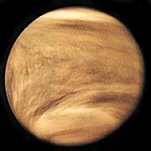
Ultraviolet (Pioneer) |

Visible (Galileo) |
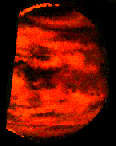
Infrared (Galileo) |
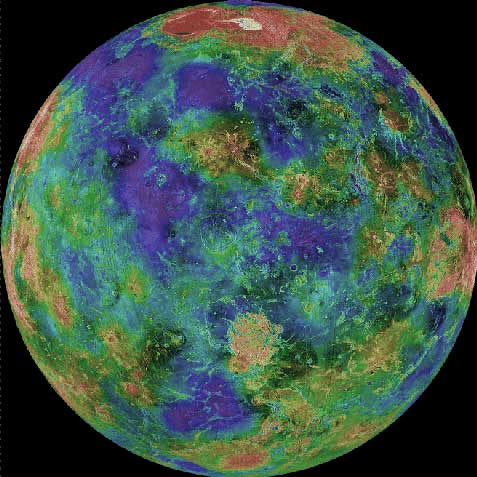
Radio (Magellan/Arecibo) |
The ultraviolet view of Venus reveals a thick atmosphere due to a runaway greenhouse effect that causes surface temperatures to reach many hundreds of degrees. The visible light image also shows the thick cloud cover that perpetually enshrouds the surface. In the infrared, we can look deeper into the atmosphere and see more details. The brighter areas are where heat from the lower atmosphere shines through sulfuric acid clouds (dark areas). Longer radio waves can completely penetrate the thick cloud cover, allowing scientists to beam radar waves to map the surface features of Venus.
Let's see what the giant gas planet Saturn and its ring system look like at different wavelengths.
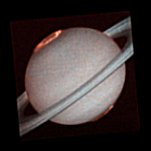
Ultraviolet J. Trauger JPL/NASA |
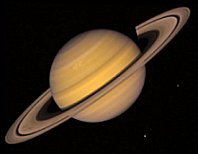
Visible NASA/JPL/Voyager |
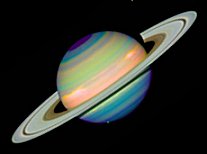
Infrared E. Karkoschka UA/HST/NASA |
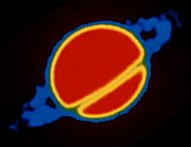
Radio NRAO |
Ultraviolet reveals Saturn's auroras which are over 1,000 miles above the clouds. These auroras are caused by solar wind particles interacting with the gases in Saturn's atmosphere. Particles from the Sun are guided to Saturn's polar regions by the planet's magnetic field where they cause emission from atomic and molecular hydrogen in the atmosphere. In visible light we begin to see features in Saturn's atmosphere as well as in its vast ring system. The infrared view shows us more detailed features in the atmosphere with the different colors showing different heights and compositions in the cloud layers. The radio image shows that Saturn actually emits radio waves and that its rings absorb radiation from the planet. Notice the bright emission from the section of the ring in front of Saturn.
Our Sun is a normal star, but looks very different across the electromagnetic spectrum.
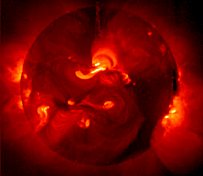
X-Ray (Yohkoh) |
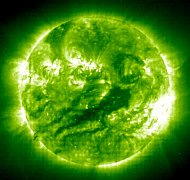
Ultraviolet (SOHO) |
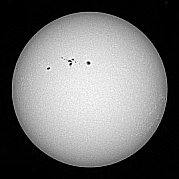
Visible (BBSO) |

Infrared (NSO) |
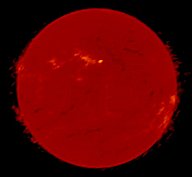
Radio (Nobeyama) |
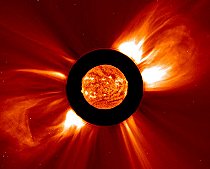
|
By observing the Sun in different parts of the spectrum, we can get information about the different layers in the Sun's atmosphere. X-ray images show us the structure of the hot corona - the outermost layer of the Sun. The brightest regions in the X-ray image are violent, high-temperature solar flares. The ultraviolet image shows additional regions of activity deeper in the Sun's atmosphere. In visible light we see sunspots on the Sun's surface. The infrared photo shows large, dark regions of cooler, denser gas where the infrared light is absorbed. The radio image show us the middle layer of the Sun's atmosphere. The composite image to the left shows an ultraviolet view of the Sun (center) along with a visible light view of the Sun's corona. Combined images like this can show how features and events near the surface of the Sun are connected with the Sun's outer atmosphere. For more details about the Sun at different wavelengths, see our Multiwavelength Gallery. |

|

|

|